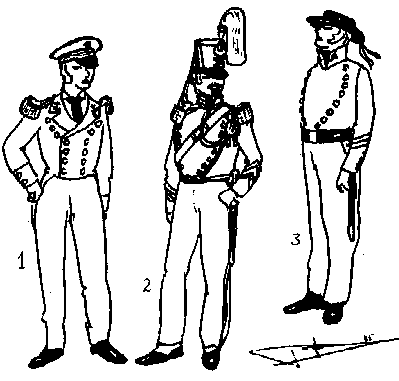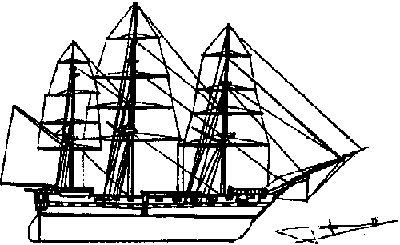
In 1838, in order to obtain payment of claims in an affair called the "Pastry War", through one of the claimants being a French baker living in Mexico, France occupied the Vera Cruz. It began on the 16th April 1838 when a French fleet began to blockade the eastern coast of Mexico, including the ports. This provoked the Mexican President Juan Alvarez to increase the size of the Mexican Army up to the strength of 60,000 men in order to "defend the Nation against any foreign aggression and to maintain internal order".
The 27th November, at 2.15 p.m., saw the beginning of the French bombardment of the San Juan de Ulua Castle that guards the entrance to Vera Cruz harbour, with 150 guns and mortars used by the French in this bombardment. These were onboard 4 Frigates ( the "Nereide", "Glorie", "Iphigene" and "Meduse" ), 2 Corvettes, 2 Gunboats and 2 Brigantines. The French commander of these ships was Rear Admiral Charles Baudin (1786-1854) who was onboard his flagship the "Nereide," a 52-gun Frigate, while in command of the Corvette "La Creole" was the son of King Louis Philippe, the Prince de Joinville. The bombardment lasted until 8 pm. when the Mexican garrison capitulated due to one of its bastions being blown up, and an agreement was signed onboard the "Nereide" between Rear Admiral Baudin and the Mexican commander of the Vera Cruz Province, General Manuel Rincon, with a promise of the end to hostilities. This operation was later described by the Duke of Wellington as "the first example of a seacoast fortress being reduced by an entirely naval force."
The Mexican Government refused to ratify this capitulation and dispatched General Santa Anna to defeat the French, while declaring war on King Louis Philippe of France. Santa Anna occupied Vera Cruz, causing a number of French civilians to seek refuge with the fleet. Rear Admiral Baudin launched a surprise attack on Vera Cruz with his sailors and "artilleurs de marine" against the city on the 5th December.
These were divided into two columns led by Commandants Parseval and Laine. This landing managed to succeed according to plan, with the capture of General Arista who was protecting the flight of Santa Anna--who had been in his bed at the beginning of the assault. Deciding that his forces had inflicted enough damage to the Mexicans, Rear Admiral Baudin ordered the re-embarkation of the landing parties, without further pursuing his success.
Santa Anna, having rallied a strong force, used this time to counter-attack. Meanwhile, the Rear Admiral and his Staff had landed to control the operation better and with this Mexican attack he ordered his Frigates and armed launches to fire at Santa Anna's forces, who being caught in this crossfire soon retired with Santa Anna being wounded in his leg (having to be cut off later).
The Mexican losses for these actions have, as far as I know, never been noted although the assault on Vera Cruz cost the Mexicans several hundred troops in killed and wounded. The French lost 14 dead and 94 wounded. After this action a treaty was signed between Mexico and France that ended the war, with France obtaining satisfaction for her grievances.
Illustrations
 Fig. 1. French Naval Officer, Lieutenant de vaisseau. Peaked cap in blue cloth with gold lace trim and black leather visor and chin-strap. Jacket blue with blue collar, turnbacks and lapels, gilt buttons and gold lace lapel insignia, gold lace epaulettes, white shirt with black tie,
trousers white with black shoes.
Fig. 1. French Naval Officer, Lieutenant de vaisseau. Peaked cap in blue cloth with gold lace trim and black leather visor and chin-strap. Jacket blue with blue collar, turnbacks and lapels, gilt buttons and gold lace lapel insignia, gold lace epaulettes, white shirt with black tie,
trousers white with black shoes.
Fig. 2. Sous-Officer, Artilleur de Marine (Regulation Dress) Shako blue with red top band, side chevrons, cords and rackettes, brass plate and plume holder, plume is red, national cockade under plume holder with cockade holding yellow lace, black visor. Tunic is blue with blue collar, cuffs and lapels these are all piped in red, sleeve rank insignia is yellow lace, red epaulettes, brass buttons, trousers in blue with red side stripe, white spats, black shoes, white leather belts and straps.
 Fig. 3. Quartier Maitre Black straw hat with black ribbon, jacket in blue with
blue collar and cuffs, collar has red patches, yellow rank lace on sleeve,
brass buttons, trousers white, black shoes, black leather waistbelt and
hanger, side arm in black leather scabbard with brass fittings, brass
waistbelt buckle.
Fig. 3. Quartier Maitre Black straw hat with black ribbon, jacket in blue with
blue collar and cuffs, collar has red patches, yellow rank lace on sleeve,
brass buttons, trousers white, black shoes, black leather waistbelt and
hanger, side arm in black leather scabbard with brass fittings, brass
waistbelt buckle.
Fig. 4. Frigate "Nereide"
Sources
"Histoire de la Marine Francaise", by Claude Farrere, 1963.
"El Soldado Mexicano 1837-47", By Nieto, Brown & Hefter, Mexico, 1958.
"Marine et Imagerie du 17me au 20me siecle".
"Revue Marine", No.165, Oct. 1994.
"French Navy in Mexico, 1838", by Eugene Leliepure and Jacques Brouillet, Company of Military Historians, Washington DC, article and plate No.323.
Back to Table of Contents -- El Dorado Vol VII No. 3
© Copyright 1996 by The South and Central Military Historians Society